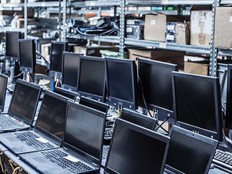Wyse's Thinnest of the Thin Computing Client
Wyse S10 Thin Client.
Wyse, a longtime leader in thin clients, offers a number of systems that can replace desktop computers without giving up much of the user experience of a full desktop. Wyse's systems run from low-cost, bare-bones clients to high-end graphics terminals.
Among the most compact of Wyse's offerings is the company's S series – small client devices that deliver the graphics and multimedia features of a standard PC without the management headaches that go along with supporting a fleet of desktops.
The thinnest of the thin in the S series, Wyse's S10 model offers the benefits of thin-client computing in a remarkably small package.
End-User Advantages
The entry-level S series machine runs the Wyse Thin OS. About the size and weight of a paperback book, the S10 takes up negligible desktop space and can easily be hidden away – or, with an optional bracket, can be attached to the back of a monitor. It has no fan or disk drives and is virtually silent when in operation. These features make the S10 ideal for cramped workspaces, classrooms, task stations and other environments where the noise and size of a regular PC might be a problem.
There's not a lot of waiting around while the S10 starts up – it boots in seconds, making it ideal for a task station. The device can connect to a virtual-client session running on a server using Microsoft Windows Terminal Server, Citrix XenApp or XenDesktop, or VMware View, making it suitable for Windows or Linux desktops or application-specific sessions.
With four USB 2.0 ports, the S10 comes with a USB keyboard with a built-in PS-2 mouse port and mouse, simplifying cord management. With USB virtualization software from Wyse that's sold separately, you can use other USB devices (such as webcams, printers and connected phones or PDAs), giving users something close to the convenience of their own PC. The S10 also includes headphone and microphone jacks to support multimedia and audio applications.
Why It Works for IT
The most attractive aspects of the S10 for IT are its security and economy. Because the unit uses a proprietary, firmware-based operating system, it's invulnerable to viruses and malware (though the overall security of the configuration depends on how you manage your server). Also, files can't be loaded into a user session from a USB drive or other source by default.
And like all hardware-based thin clients, using the S10 means that all the processing power, software and peripherals are controlled by the server. This means there is no threat by default of users uploading data to the network or downloading onto a thumb drive or other removable media, and you can control printing features and transfer information.
Because all the processing power is on the server, the S10 theoretically has a long lifecycle. The unit is not integrated with a monitor, so its useful life is not linked to a display.
And with no disk drive or fan, it draws a fraction of the power of a standard PC – using just 6 watts of power, compared with a typical 200-watt desktop.
The cherry on top is the price of the S10 itself. At less than $300, the device is inexpensive enough to deploy widely in classrooms, libraries, call centers and at telecommuting centers or other places where people work remotely.
Disadvantages
The S10 is designed for “task-centric” computing, and its performance is tied directly to that of the terminal server. Other models in the S series offer stand-alone functionality based on embedded Windows or Linux operating systems and can deliver greater overall functionality without being tied to a terminal server. If you're using web-based software (such as a cloud computing application), one of the high-end S series terminals might be a better fit.






